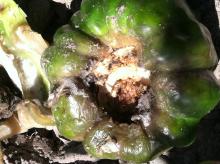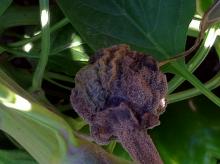See:
Pepper (Capsicum spp.) - White Mold
Cause The fungus, Botrytis cinerea (teleomorph: Botryotinia fuckeliana), is an opportunistic pathogen that easily invades weak, damaged, or senescing tissue. Usually, it is more of a problem on seedlings in greenhouses but can be a problem in the field when humid conditions are present. All aboveground portions of the pepper plant can be attacked but often disease starts on senescing flowers or fruit damaged by sunscald. Spores (conidia) are produced throughout the growing season under a wide range of temperatures and humidity. Cool temperatures (68°F is optimal but the fungus can grow between 50°F and 80°F), high humidity, and free water on plant surfaces favor the disease, as do close plant spacing and irrigation practices that keep plants wet for a longer time. Fields adjacent to water ways may be especially prone to developing both gray and white mold outbreaks in the Willamette Valley. Epidemics have been observed in the Willamette Valley of Oregon, where gray mold was found on bell pepper also infected with Sclerotinia (the causal agent of white mold).
Symptoms The symptoms first appear on petals, injured fruit, or senescing leaves and is initially a dark, water-soaked, slimy lesion and then the affected areas turn tan to light-brown before turning brownish-gray and powdery-looking as spores develop. Petioles, stems, and fruit can develop lesions. Green or ripe fruit infections cause a soft, brown-to-gray rot that can eventually encompass the entire fruit. Plants can die from stem infections.
Cultural control
- Rotate out of pepper and beans to cereals and corn for at least two years.
- Thoroughly incorporate green manures or cover crops and allow debris to decompose before establishing a new crop.
- Limit irrigation during and after bloom. Irrigate in the morning so plants do not stay wet more than 12 hours. In some areas, growers may be able to irrigate heavily before bloom and as little as possible thereafter.
- Avoid over-fertilization with nitrogen.
- In greenhouse production, decrease high relative humidy with adequate ventilation or heating.
Chemical control
- Carboxamide (Group 7) formulations are registered for use on pepper. Do not make more than two (2) sequential applications before alternating to a labeled fungicide with a different mode of action.
- Endura at 3.5 oz/A is registered for use on pepper for other diseases and so can be used in Oregon for gray mold. Preharvest interval is 0 days. 12-hr reentry.
- Fontelis at 10 to 24 fl oz/A prior to disease development on a 7- to 14-day interval. Preharvest interval is 0 days. 12-hr reentry.
- Chlorothalonil (Group M5) products also are registered but do not control gray mold as well as dicarboximides and are ineffective against white mold; however, they may be useful if resistance to other fungicides is a problem.
- Bravo Ultrex at 1.4 lb/A. Do not apply within 3 days of harvest. Do not graze treated areas or feed treated plant parts to livestock. 12-hr reentry.
- Echo 720 at 1.5 pints/A on 7- to 10-day intervals when disease threatens. Preharvest interval is 3 days. 12-hr reentry.
- Cueva (Group M1) at 0.5 to 2 gal/100 gal water on 7- to 10-day intervals. May be applied up to the day of harvest. Poor control as a stand-alone product. 4-hr reentry. O
- Inspire Super (Group 3 + 9) at 16 to 20 fl oz/A on 7- to 10-day intervals with no more than two (2) sequential applications. Preharvest interval is 0 days. 12-hr reentry.
- Orondis Opti (Group M5 + 49) at 1.75 to 2.5 pints/A on 7- to 10-day intervals. Do not apply more than two (2) sequential applications. Preharvest interval is 3 days. 12-hr reentry.
- Regalia (Group P5) at 1 to 4 quarts/A plus another fungicide on 7- to 10-day intervals. Does not benefit from the addition of an adjuvant. Preharvest interval is 0 days. 4-hr reentry. O
- Switch 62.5WG (Group 9 + 12) at 11 to 14 oz./A on 7- to 10-day intervals. Do not apply for than two (2) sequential applications. May be applied the day of harvest. 12-hr reentry.
- Trilogy at 0.5% to 1%. Not labeled for use in Oregon. Do not use above 90°F or when plants are under heat or moisture stress. Do not use when foliage is wet as good coverage is essential. Poor control as a stand-alone product. 4-hr reentry. O
- Vacres (potassium bicarbonate) at 2.5 to 5 lb/A on 7- to 14-day intervals. Preharvest interval is zero (0) days. 4-hr reentry.
Biological control Efficacy in the Pacific Northwest is unknown.
- Actinovate AG at 3 to 12 oz/A as a foliar spray on 7- to 14-day intervals. 4-hr reentry. O
- Actinovate Lawn & Garden at 1/2 to 1 teaspoon/gal water. H O
- LifeGard WG at 1 to 4.5 oz/100 gal on 7- to 14-day intervals for activating plant resistance. Refer to label for appropriate rate per application volume. Preharvest interval is 0 days. 4-hr reentry. O
- Serenade Opti at 14 to 20 oz/A on 7- to 10-day intervals. Applications can be made up to and the day of harvest. 4-hr reentry. O
- Stargus at 2 to 4 quarts/A plus a nonionic surfactant on 7- to 10-day intervals. Preharvest interval is 0 days. 4-hr reentry. O
Reference Hall, R. 1991. Compendium of Bean Diseases. St. Paul, MN: APS Press.


